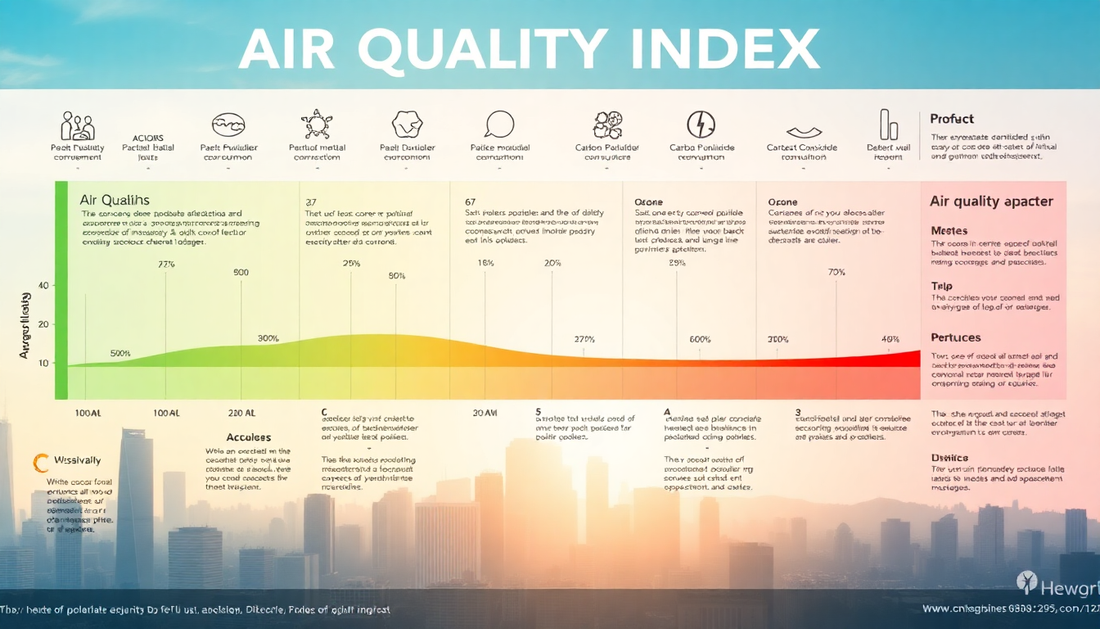Air quality is a critical factor that affects our health, the environment, and our daily lives. The Air Quality Index (AQI) is a widely used metric that helps us understand the current state of the air we breathe. In this comprehensive guide, we'll explore the ins and outs of AQI, its implications, and how we can work towards improving air quality.
What is AQI?
The Air Quality Index (AQI) is a numerical scale that represents the level of air pollution in a specific location. It is a standardized system used by government agencies and environmental organizations around the world to communicate air quality information to the public. The AQI ranges from 0 to 500, with higher values indicating more polluted air.
The AQI is calculated based on the concentrations of several key air pollutants, including:
- Particulate matter (PM2.5 and PM10)
- Ozone (O3)
- Carbon monoxide (CO)
- Sulfur dioxide (SO2)
- Nitrogen dioxide (NO2)
Each of these pollutants is assigned a sub-index value, and the overall AQI is determined by the highest sub-index value.
Understanding AQI Levels
The AQI is divided into six color-coded categories, each with its own health implications:
- Good (0-50): The air quality is considered satisfactory, and air pollution poses little or no risk.
- Moderate (51-100): The air quality is acceptable, but some pollutants may pose a moderate health concern for a small number of people who are unusually sensitive to air pollution.
- Unhealthy for Sensitive Groups (101-150): Members of sensitive groups may experience health effects, but the general public is not likely to be affected.
- Unhealthy (151-200): Everyone may begin to experience health effects, and members of sensitive groups may experience more serious health effects.
- Very Unhealthy (201-300): Health warnings of emergency conditions. The entire population is more likely to be affected.
- Hazardous (301-500): Health alert: everyone may experience more serious health effects.
Health Implications of AQI
The health effects of air pollution can vary depending on the AQI level and the individual's sensitivity. Exposure to high levels of air pollution can lead to a range of respiratory and cardiovascular problems, including:
- Aggravated asthma
- Decreased lung function
- Irregular heartbeat
- Nonfatal heart attacks
- Increased risk of premature death
Certain populations, such as children, the elderly, and individuals with pre-existing medical conditions, are more vulnerable to the adverse health effects of air pollution.
Factors Affecting AQI
The AQI is influenced by a variety of factors, both natural and human-made. Some of the key contributors to air pollution include:
- Industrial emissions
- Vehicle exhaust
- Wildfires and forest fires
- Dust storms
- Agricultural activities
- Residential wood burning
These sources can release a variety of pollutants into the atmosphere, which can then be affected by weather patterns, topography, and other environmental conditions.
Measuring and Monitoring AQI
Governments and environmental agencies around the world use a network of air quality monitoring stations to measure and report AQI levels. These stations use specialized equipment to detect and quantify the concentrations of different air pollutants. The data collected is then used to calculate the overall AQI for a given location.
In addition to government-run monitoring systems, there are also a growing number of citizen-science initiatives and low-cost air quality sensors that allow individuals to track air quality in their local communities.
Improving Air Quality
Improving air quality is a complex challenge that requires a multi-faceted approach involving individuals, communities, and governments. Some strategies for improving air quality include:
- Promoting the use of clean energy sources and reducing reliance on fossil fuels
- Implementing stricter regulations and enforcement on industrial emissions and vehicle emissions
- Encouraging the adoption of energy-efficient technologies and sustainable transportation options
- Investing in public transportation and infrastructure that supports walking, cycling, and other low-emission modes of travel
- Educating the public on the importance of air quality and empowering them to make eco-friendly choices
By working together, we can take meaningful steps to improve air quality and protect the health of our communities and the environment.
Global Perspectives on AQI
Air quality is a global issue, with significant variations in AQI levels across different regions of the world. Some countries and cities have made significant strides in improving air quality, while others continue to struggle with high levels of air pollution.
Comparative analyses of AQI data from around the world can provide valuable insights into the challenges and successes of air quality management efforts. By learning from the experiences of other regions, we can develop more effective strategies for addressing air pollution and promoting sustainable development.
Conclusion
The Air Quality Index (AQI) is a crucial tool for understanding and addressing the state of the air we breathe. By being informed about AQI levels and their health implications, we can make more informed decisions and take action to improve air quality in our communities.
As we continue to face the global challenge of air pollution, it is essential that we work together – as individuals, communities, and nations – to implement comprehensive solutions and create a cleaner, healthier future for all.

